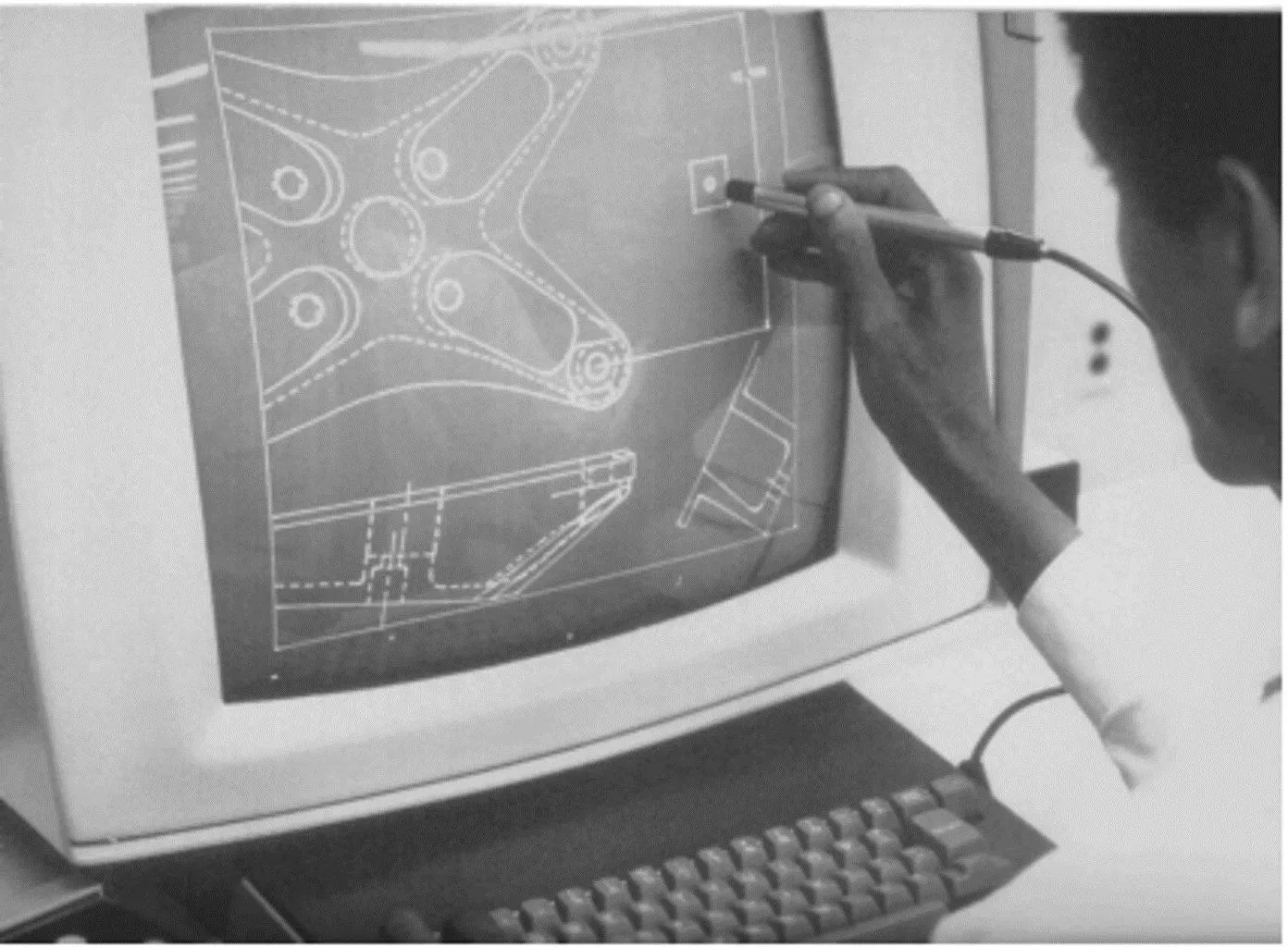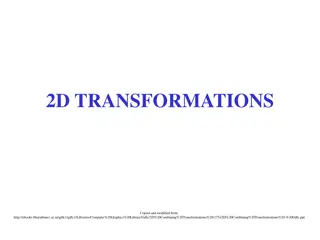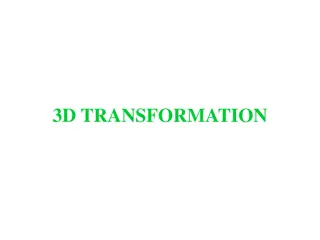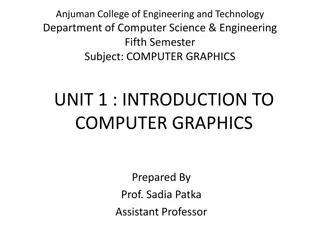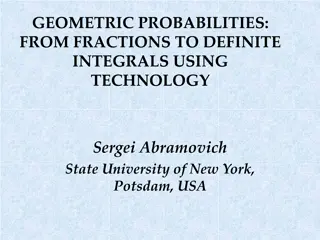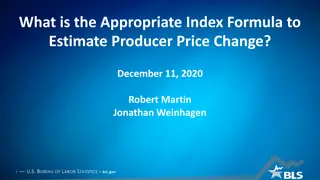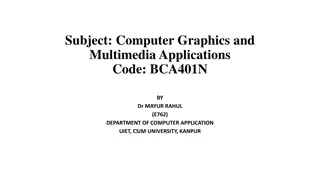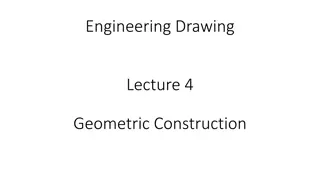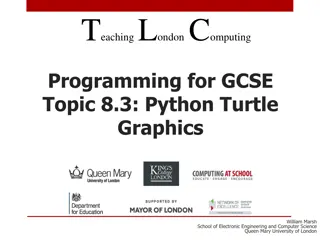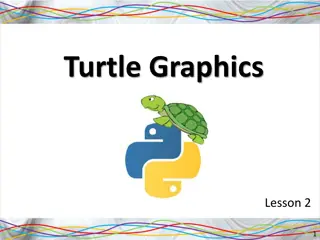2D Geometric Transformations for Computer Graphics
In this lecture on 2D Geometric Transformations, Assistant Professor Dr. Samsun M. BA ARICI covers topics such as translation, rotation, scaling, homogeneous representations, and coordinates. The lecture delves into basic transformations like reflection and shearing, as well as practical applications such as OpenGL transformations. Various modeling and rigid-body transformations are explored, offering insights into changing object positions, orientations, and sizes without deformation. The lecture also discusses methods for implementing transformations in 2D coordinate systems.
Download Presentation

Please find below an Image/Link to download the presentation.
The content on the website is provided AS IS for your information and personal use only. It may not be sold, licensed, or shared on other websites without obtaining consent from the author. Download presentation by click this link. If you encounter any issues during the download, it is possible that the publisher has removed the file from their server.
E N D
Presentation Transcript
CSE 411 Computer Graphics Lecture #6 2D Geometric Transformations Prepared & Presented by Asst. Prof. Dr. Samsun M. BA ARICI
Objectives HB Ch. 7, GVS Ch. 3 Basic 2D Transformations (rigid-body transformations): Translation Rotation Scaling Homogenenous Representations and Coordinates 2D Composite Transformations 2D Geometric Transformations 2
Objectives (cont.) Other Transformations: Reflection Shearing Raster Methods for Transformations and OpenGL Transformations between 2D Coordinate Systems and OpenGL 2D Geometric Transformations 3
Geometric Transformations Sometimes also called modeling transformations Geometric transformations: Changing an object s position (translation), orientation (rotation) or size (scaling) Modeling transformations: Constructing a scene or hierarchical description of a complex object Others transformations: reflection and shearing operations 2D Geometric Transformations 4
Basic 2D Geometric Transformations 2D Translation P T P x = x + tx, y = y + ty = y t ' x x x = = , ' , P P T ' t y y P =P+T Translation moves the object without deformation (rigid-body transformation) 2D Geometric Transformations 5
Basic 2D Geometric Transformations (cont.) 2D Translation To move a line segment, apply the transformation equation to each of the two line endpoints and redraw the line between new endpoints To move a polygon, apply the transformation equation to coordinates of each vertex and regenerate the polygon using the new set of vertex coordinates 2D Geometric Transformations 6
2D Translation Routine class wcPt2D { public: GLfloat x, y; }; void translatePolygon (wcPt2D * verts, GLint nVerts, GLfloat tx, GLfloat ty) { GLint k; for (k = 0; k < nVerts; k++) { verts [k].x = verts [k].x + tx; verts [k].y = verts [k].y + ty; } glBegin (GL_POLYGON); for (k = 0; k < nVerts; k++) glVertex2f (verts [k].x, verts [k].y); glEnd ( ); } 2D Geometric Transformations 7
Basic 2D Geometric Transformations (cont.) 2D Rotation Rotation axis Rotation angle rotation point or pivot point (xr,yr) yr xr 2D Geometric Transformations 8
Basic 2D Geometric Transformations (cont.) 2D Rotation If is positive counterclockwise rotation If is negative clockwise rotation Remember: cos(a + b) = cos a cos b - sin a sin b cos(a - b) = cos a sin b + sin a cos b 2D Geometric Transformations 9
Basic 2D Geometric Transformations (cont.) 2D Rotation At first, suppose the pivot point is at the origin x =r cos( + ) = r cos cos - r sin sin y =r sin( + ) = r cos sin + r sin cos x = r cos , y = r sin x =x cos - y sin y =x sin + y cos (x ,y ) r (x,y) r 2D Geometric Transformations 10
Basic 2D Geometric Transformations 2D Rotation P =R P cos cos sin = R sin (x ,y ) r (x,y) r 2D Geometric Transformations 11
Basic 2D Geometric Transformations (cont.) 2D Rotation Rotation of a point about any specified position (xr,yr) x =xr+(x - xr) cos (y - yr) sin y =yr+(x - xr) sin + (y - yr) cos Rotations also move objects without deformation A line is rotated by applying the rotation formula to each of the endpoints and redrawing the line between the new end points A polygon is rotated by applying the rotation formula to each of the vertices and redrawing the polygon using new vertex coordinates 2D Geometric Transformations 12
2D Rotation Routine class wcPt2D { public: GLfloat x, y; }; void rotatePolygon (wcPt2D * verts, GLint nVerts, wcPt2D pivPt, GLdouble theta) { wcPt2D * vertsRot; GLint k; for (k = 0; k < nVerts; k++) { vertsRot [k].x = pivPt.x + (verts [k].x - pivPt.x) * cos (theta) - (verts [k].y - pivPt.y) * sin (theta); vertsRot [k].y = pivPt.y + (verts [k].x - pivPt.x) * sin (theta) + (verts [k].y - pivPt.y) * cos (theta); } glBegin (GL_POLYGON); for (k = 0; k < nVerts; k++) glVertex2f (vertsRot [k].x, vertsRot [k].y); glEnd ( ); } 2D Geometric Transformations 13
Basic 2D Geometric Transformations (cont.) 2D Scaling Scaling is used to alter the size of an object Simple 2D scaling is performed by multiplying object positions (x, y) by scaling factors sxand sy x = x sx y = y sx y s y y 0 ' 0 s ' x x x = or P = S P 2D Geometric Transformations 14
Basic 2D Geometric Transformations (cont.) 2D Scaling Any positive value can be used as scaling factor Values less than 1 reduce the size of the object Values greater than 1 enlarge the object If scaling factor is 1 then the object stays unchanged If sx= sy, we call it uniform scaling If scaling factor <1, then the object moves closer to the origin and If scaling factor >1, then the object moves farther from the origin x x 2D Geometric Transformations 15
Basic 2D Geometric Transformations (cont.) 2D Scaling Why does scaling also reposition object? Answer: See the matrix (multiplication) Still no clue? ? ?= ?? 0 0 ?? ? ??+ ? 0 ? 0 + ? ?? ? ? = 2D Geometric Transformations 16
Basic 2D Geometric Transformations (cont.) 2D Scaling We can control the location of the scaled object by choosing a position called the fixed point (xf,yf) x xf= (x xf) sx y yf= (y yf) sy x =x sx+ xf(1 sx) y =y sy+ yf(1 sy) Polygons are scaled by applying the above formula to each vertex, then regenerating the polygon using the transformed vertices 2D Geometric Transformations 17
2D Scaling Routine class wcPt2D { public: GLfloat x, y; }; void scalePolygon (wcPt2D * verts, GLint nVerts, wcPt2D fixedPt, GLfloat sx, GLfloat sy) { wcPt2D vertsNew; GLint k; for (k = 0; k < n; k++) { vertsNew [k].x = verts [k].x * sx + fixedPt.x * (1 - sx); vertsNew [k].y = verts [k].y * sy + fixedPt.y * (1 - sy); } glBegin (GL_POLYGON); for (k = 0; k < n; k++) glVertex2v (vertsNew [k].x, vertsNew [k].y); glEnd ( ); } 2D Geometric Transformations 18
Matrix Representations and Homogeneous Coordinates Many graphics applications involve sequences of geometric transformations Animations Design and picture construction applications We will now consider matrix representations of these operations Sequences of transformations can be efficiently processed using matrices 2D Geometric Transformations 19
Matrix Representations and Homogeneous Coordinates (cont.) P = M1 P + M2 P and P are column vectors M1is a 2 by 2 array containing multiplicative factors M2is a 2 element column matrix containing translational terms For translation M1is the identity matrix For rotation or scaling, M2contains the translational terms associated with the pivot point or scaling fixed point 2D Geometric Transformations 20
Matrix Representations and Homogeneous Coordinates (cont.) To produce a sequence of operations, such as scaling followed by rotation then translation, we could calculate the transformed coordinates one step at a time A more efficient approach is to combine transformations, without calculating intermediate coordinate values 2D Geometric Transformations 21
Matrix Representations and Homogeneous Coordinates (cont.) Multiplicative and translational terms for a 2D geometric transformation can be combined into a single matrix if we expand the representations to 3 by 3 matrices We can use the third column for translation terms, and all transformation equations can be expressed as matrix multiplications 2D Geometric Transformations 22
Matrix Representations and Homogeneous Coordinates (cont.) Expand each 2D coordinate (x,y) to three element representation (xh,yh,h) called homogeneous coordinates h is the homogeneous parameter such that x = xh/h, y = yh/h, infinite homogeneous representations for a point A convenient choice is to choose h = 1 2D Geometric Transformations 23
Matrix Representations and Homogeneous Coordinates (cont.) 2D Translation Matrix = 0 1 ' 1 0 x t x x ' 0 1 y t y y 0 1 1 or, P = T(tx,ty) P 2D Geometric Transformations 24
Matrix Representations and Homogeneous Coordinates (cont.) 2D Rotation Matrix cos ' cos sin 0 x x ' = sin 0 y y 1 0 0 1 1 or, P = R( ) P 2D Geometric Transformations 25
Matrix Representations and Homogeneous Coordinates (cont.) 2D Scaling Matrix ' 0 s 0 x s x x ' = 0 0 y y y 1 0 0 1 1 or, P = S(sx,sy) P 2D Geometric Transformations 26
Inverse Transformations 2D Inverse Translation Matrix = 0 1 0 t x 1 0 1 T t y 0 1 By the way: * = 1 T T I 2D Geometric Transformations 27
Inverse Transformations (cont.) 2D Inverse Rotation Matrix cos sin 0 = 1 sin cos 0 R 0 0 1 And also: * = 1 R R I 2D Geometric Transformations 28
Inverse Transformations (cont.) 2D Inverse Rotation Matrix: If is negative clockwise In R R = * 1 I Only sine function is affected Therefore we can say R R = 1 T Is that true? Proof: It s up to you 2D Geometric Transformations 29
Inverse Transformations (cont.) 2D Inverse Scaling Matrix 1 s 0 0 x 1 s = 1 0 0 S y 0 0 1 Of course: * = 1 S S I 2D Geometric Transformations 30
2D Composite Transformations We can setup a sequence of transformations as a composite transformation matrix by calculating the product of the individual transformations P =M2 M1 P =M P 2D Geometric Transformations 31
2D Composite Transformations (cont.) Composite 2D Translations If two successive translation are applied to a point P, then the final transformed location P' is calculated as = = + + P T T P T P ' ( , ) ( , ) ( , ) t t t t t t t t x y x y x x y y 2 2 1 1 1 2 1 2 + 1 0 1 0 1 0 t t t t 2 1 1 2 x x x x = + 1 0 1 0 1 0 1 t t t t 2 1 1 2 y y y y 0 0 1 0 0 1 0 0 2D Geometric Transformations 32
2D Composite Transformations (cont.) Composite 2D Rotations = + P R P ' ( ) 1 2 cos cos + cos( + cos sin 0 cos sin 0 cos( ) sin( ) 0 2 2 1 1 1 2 1 2 0 0 = + + sin 0 sin 0 sin( ) ) 0 2 2 1 1 1 2 1 2 0 1 0 1 0 0 1 2D Geometric Transformations 33
2D Composite Transformations (cont.) Composite 2D Scaling = S S S ( , ) ( , ) ( , ) s s s s s s s s x y x y x x y y 2 2 1 1 1 2 1 2 0 0 0 0 0 0 0 s s s s 2 1 1 2 x x x x = 0 0 0 0 0 0 s s s s 2 1 1 2 y y y y 0 0 1 0 0 1 0 1 2D Geometric Transformations 34
2D Composite Transformations (cont.) Don t forget: Successive translations are additive Successive scalings are multiplicative For example: If we triple the size of an object twice, the final size is nine (9) times the original 9 times? Why? Proof: Again up to you 2D Geometric Transformations 35
General Pivot Point Rotation Steps: Translate the object so that the pivot point is moved to the coordinate origin. Rotate the object about the origin. Translate the object so that the pivot point is returned to its original position. 1. 2. 3. 2D Geometric Transformations 36
General Pivot Point Rotation 2D Geometric Transformations 37
2D Composite Transformations (cont.) General 2D Pivot-Point Rotation 0 1 0 0 cos 1 0 cos sin 0 1 0 x x r r 0 1 sin 0 0 1 y y r r 0 1 0 0 1 cos + cos sin 1 ( r y cos ) sin x y r = 1 sin 1 ( r cos ) sin x r 0 0 2D Geometric Transformations 38
General Fixed Point Scaling Steps: Translate the object so that the fixed point coincides with the coordinate origin. Scale the object about the origin. Translate the object so that the pivot point is returned to its original position. 1. 2. 3. 2D Geometric Transformations 39
General Fixed Point Scaling (cont.) (xr, yr) (xr, yr) 2D Geometric Transformations 40
General Fixed Point Scaling (cont.) General 2D Fixed-Point Scaling: 1 0 ?? 0 1 ?? 0 0 1 1 0 ?? 0 1 ?? 0 0 1 ??0 ??(1 ??) 0 ????(1 ??) 0 0 ??0 0 0 ??0 0 0 1 . . = 1 ?(??,??) ?(??,??) ?( ??, ??) = ?(??,??,??,??) 2D Geometric Transformations 41
2D Composite Transformations (cont.) General 2D scaling directions: Above: scaling parameters were along x and y directions What about arbitrary directions? Answer: See next slides 2D Geometric Transformations 42
General 2D Scaling Directions Scaling parameters s1and s2along orthogonal directions defined by the angular displacement . 2D Geometric Transformations 43
General 2D Scaling Directions (cont.) General procedure: Rotate so that directions coincides with x and y axes Apply scaling transformation ? ?1,?2 Rotate back The composite matrix: ?1cos2 + ?2sin2 ?2 ?1cos sin 0 1. 2. 3. ?2 ?1cos sin 0 ?1sin2 + ?2cos2 0 0 ? 1 ? ?1,?2 ? = 1 2D Geometric Transformations 44
2D Composite Transformations (cont.) Matrix Concatenation Properties: Matrix multiplication is associative ! M3 M2 M1= (M3 M2 ) M1 = M3 ( M2 M1 ) A composite matrix can be created by multiplicating left- to-right (premultiplication) or right-to-left (postmultiplication) Matrix multiplication is not commutative ! M2 M1 M1 M2 2D Geometric Transformations 45
2D Composite Transformations (cont.) Matrix Concatenation Properties: But: Two successive rotations Two successive translations Two successive scalings are commutative! Why? Proof: You got it: Up to you 2D Geometric Transformations 46
Reversing the order in which a sequence of transformations is performed may affect the transformed position of an object. In (a), an object is first translated in the x direction, then rotated counterclockwise through an angle of 45 . In (b), the object is first rotated 45 counterclockwise, then translated in the x direction 2D Geometric Transformations 47
Other 2D Transformations Reflection Transformation that produces a mirror image of an object 2D Geometric Transformations 48
Other 2D Transformations (cont.) Reflection Image is generated relative to an axis of reflection by rotating the object 180 about the reflection axis Reflection about the line y=0 (the x axis) (previous slide) 1 0 0 1 0 0 0 1 0 2D Geometric Transformations 49
Other 2D Transformations (cont.) Reflection Reflection about the line x=0 (the y axis) 1 0 0 0 1 0 0 0 1 2D Geometric Transformations 50





